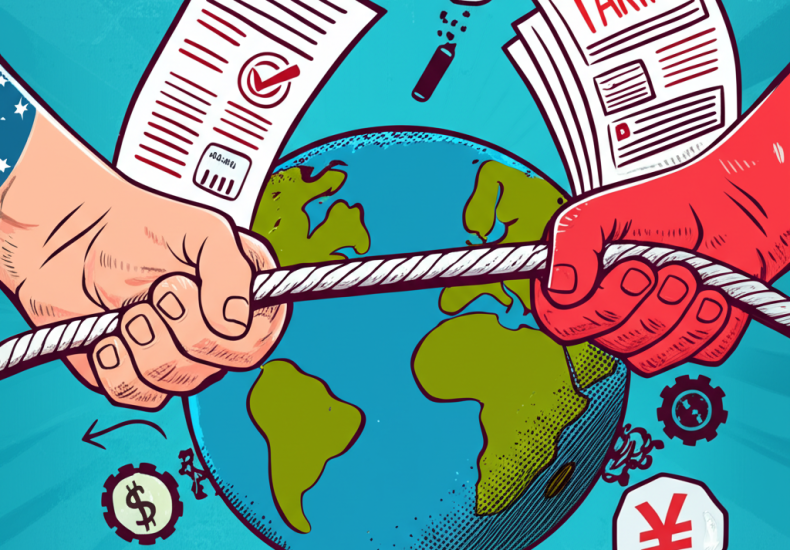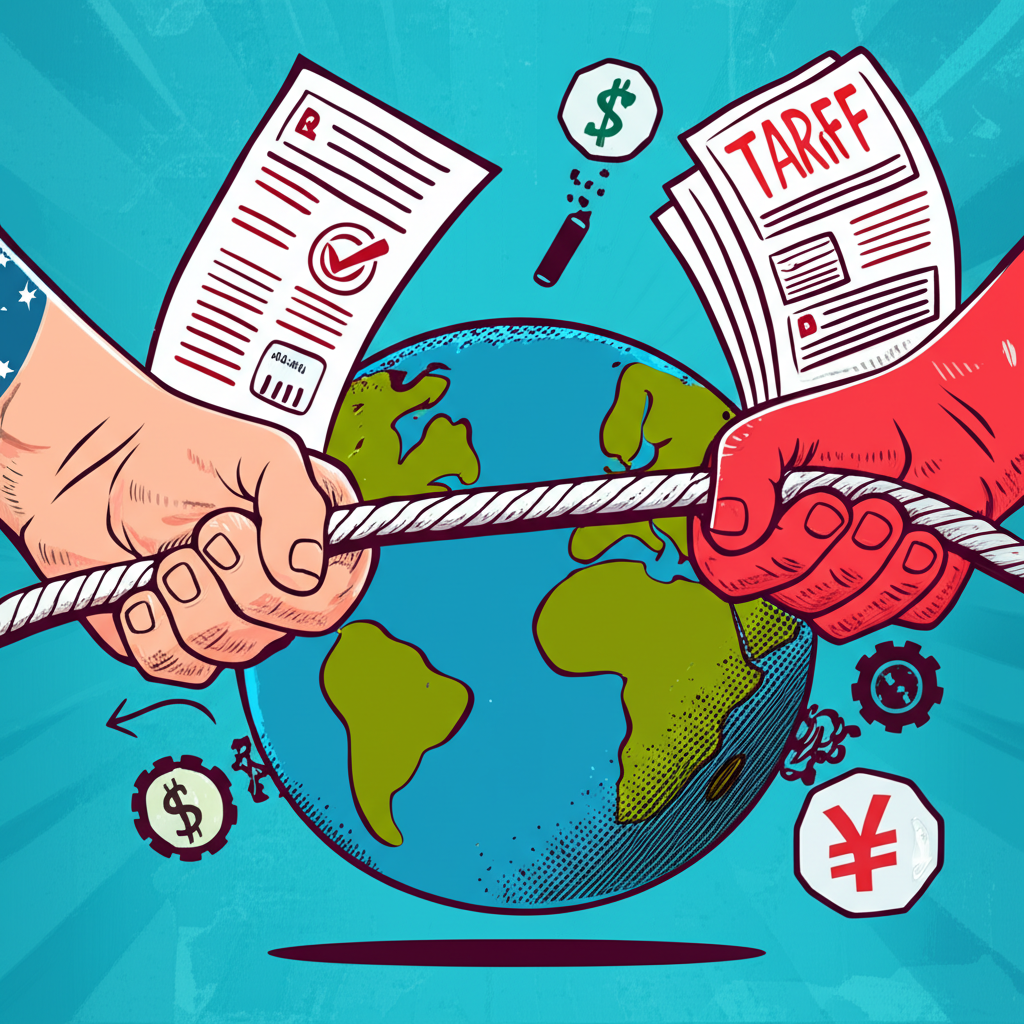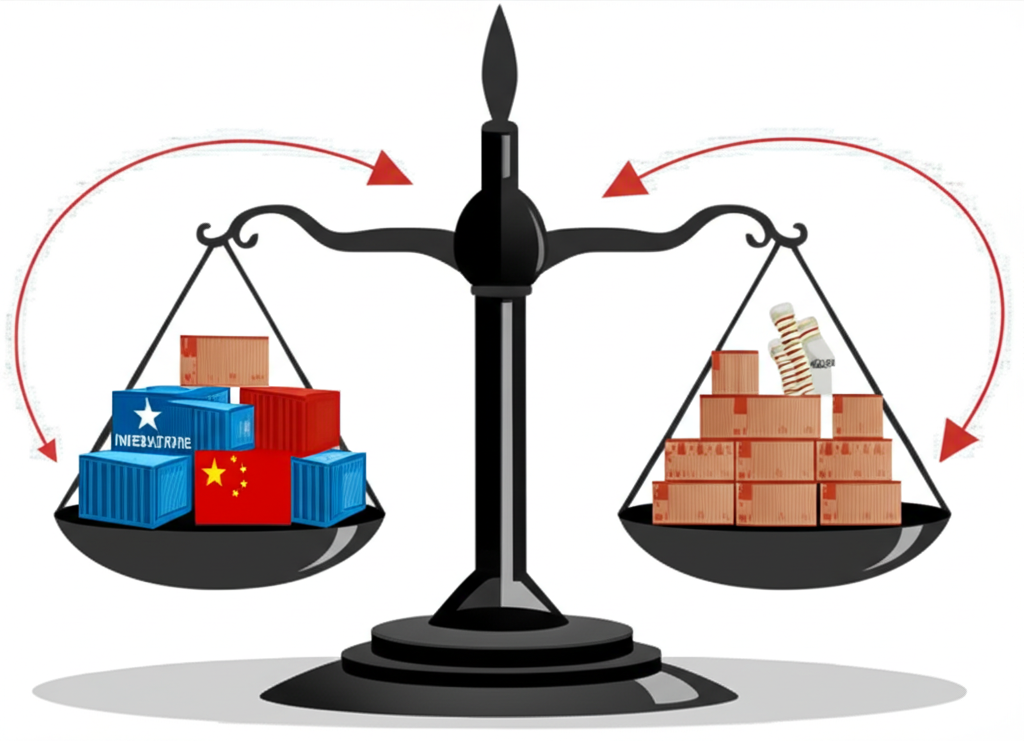
US-China Trade War Summary: 5 Key Causes and Its Lasting Global Impact
Table of Contents
ToggleThe US-China Trade War: A Defining Economic and Geopolitical Conflict

What began as a series of tariff impositions in 2018 rapidly escalated into one of the most consequential economic confrontations of the 21st century. The US-China trade war, initiated under the Trump administration, was never merely about balancing trade ledgers—it marked a turning point in the global order, reflecting deeper structural tensions between the world’s two largest economies. Far from a short-lived policy dispute, it evolved into a multifaceted strategic rivalry that reshaped international supply chains, redefined technological competition, and recalibrated geopolitical alliances. By levying tariffs on hundreds of billions of dollars in goods, both nations set in motion economic ripple effects that extended well beyond their borders, challenging decades of globalization and free-market integration. Rooted in long-standing imbalances and strategic mistrust, the conflict exposed the fragility of interdependence in an era of rising nationalism and technological competition.
Historical Roots and Escalating Tensions

The origins of the trade war stretch back decades, long before the first tariffs were imposed. Throughout the 2000s and 2010s, American policymakers and business leaders voiced growing frustration over China’s state-driven economic model. As China joined the World Trade Organization in 2001, it gained unprecedented access to global markets, but critics argued that reciprocal access was never fully granted to foreign firms. American companies faced barriers ranging from regulatory hurdles to forced joint ventures, often under conditions that pressured them to share technology. At the same time, China’s export-led growth strategy contributed to a ballooning trade surplus with the United States, drawing criticism for contributing to the decline of American manufacturing and job losses in industrial heartlands. Persistent concerns over currency valuation, industrial subsidies, and weak enforcement of intellectual property rights further deepened the sense of imbalance. These simmering grievances created a political environment ripe for confrontation, laying the foundation for the aggressive trade actions that would follow.
Core Causes: Why the Trade War Began
The decision to launch a full-scale trade offensive was not driven by a single issue but by a convergence of economic, industrial, and strategic concerns. While the immediate trigger was the imbalance in trade flows, the underlying motivations ran much deeper—touching on national security, innovation, and the future of global economic leadership.
The Persistent US Trade Deficit with China

One of the most visible drivers of the trade war was the massive and enduring trade deficit the United States ran with China. In 2017, the gap in goods trade reached over $375 billion, a figure frequently cited by the Trump administration as evidence of an unfair economic relationship. The logic was straightforward: the US was importing far more than it exported, leading to concerns about dependency and the erosion of domestic production capacity. The administration argued that this imbalance was not the result of market forces alone but of systemic distortions in China’s trade practices. The goal of the tariffs was to pressure Beijing into increasing purchases of American agricultural, energy, and manufactured goods. While some progress was made—particularly in agriculture—the deficit remained stubborn. According to the U.S. Census Bureau, the U.S. goods trade deficit with China stood at $279.4 billion in 2023, illustrating that while the imbalance has fluctuated, it has not been fundamentally resolved.
Intellectual Property Theft and Forced Technology Transfer

Beyond trade numbers, a central grievance was the systematic appropriation of American innovation. U.S. companies operating in China have long reported being required to transfer technology to local partners as a condition for market entry—a practice known as forced technology transfer. This was particularly prevalent in sectors like automotive, telecommunications, and renewable energy. In addition, there were widespread reports of cyber-enabled industrial espionage, with Chinese state-backed actors allegedly targeting U.S. firms to steal trade secrets, software blueprints, and proprietary research. The U.S. Trade Representative’s Section 301 investigation concluded that these practices cost American businesses billions annually and threatened the country’s long-term technological edge. The fear was not just about lost revenue, but about enabling a strategic competitor to leapfrog in critical fields such as artificial intelligence, biotechnology, and advanced manufacturing.
State Subsidies and Unfair Market Practices
Another major point of contention was China’s use of state-directed economic tools to support domestic industries. Through state-owned enterprises, government-backed financing, and subsidized land and energy, Chinese firms received advantages that private-sector competitors in open markets could not match. Programs like “Made in China 2025” signaled a clear intent to dominate high-tech industries, raising alarms in Washington and among U.S. allies. American and European businesses often found themselves at a disadvantage when bidding for contracts or competing in third markets, where Chinese companies could underprice due to government support. These practices were viewed as a distortion of fair competition, undermining the rules-based trading system that the U.S. had long championed. The trade war, in part, became a vehicle to push back against what many saw as an unfair and mercantilist economic model.
Geopolitical Competition and Technological Supremacy
Underlying the economic arguments was a broader strategic shift. The trade war coincided with a growing recognition in Washington that China was no longer just a trading partner but a peer competitor. Its rapid military modernization, global infrastructure ambitions through the Belt and Road Initiative, and advancements in emerging technologies signaled a challenge to U.S. global leadership. The focus on technology—particularly semiconductors, 5G networks, and artificial intelligence—highlighted the stakes. The U.S. decision to restrict Huawei’s access to American chipmaking tools was not solely about trade; it was a national security move designed to slow China’s rise in critical infrastructure. In this context, tariffs and export controls became tools in a larger contest for influence, innovation, and future dominance in the digital economy.
A Chronology of Conflict: Key Events and Tariff Escalation
The trade war unfolded in a series of escalating moves and counter-moves, each raising the stakes and increasing uncertainty for global markets.
The Initial Tariff Rounds (2018)
The conflict began in early 2018 with safeguard tariffs on solar panels and washing machines, followed by broad-based tariffs on steel and aluminum imports justified under national security grounds. While these applied globally, China was a primary target. The real escalation came in July 2018, when the U.S. imposed 25% tariffs on $34 billion worth of Chinese goods under Section 301 of the Trade Act of 1974, citing intellectual property violations. China responded immediately with equivalent tariffs on U.S. exports, including soybeans, pork, and automobiles—sectors with significant political and economic weight in the U.S. The tit-for-tat nature of the retaliation signaled that this would not be a short-term dispute but a sustained economic confrontation.
Escalation and Retaliation (2019)
The conflict intensified throughout 2019. In May, the U.S. raised tariffs from 10% to 25% on an additional $200 billion worth of Chinese imports, accusing Beijing of reneging on earlier commitments made during negotiations. China retaliated by imposing higher tariffs on $60 billion of U.S. goods. The economic battlefield expanded beyond tariffs when the U.S. Department of Commerce added Huawei to its Entity List, effectively cutting off the company’s access to American technology and components. This move had far-reaching implications, disrupting global telecommunications supply chains and signaling that the conflict was no longer just about trade but about technological containment. The uncertainty during this period led many multinational companies to delay investments and reevaluate their China strategies.
The “Phase One” Trade Deal (2020)
A temporary de-escalation came in January 2020 with the signing of the “Phase One” trade agreement. Under the deal, China pledged to purchase an additional $200 billion in U.S. goods and services over two years, with specific targets for agriculture, energy, and manufactured products. It also agreed to strengthen intellectual property protections and open its financial services sector to U.S. firms. In return, the U.S. rolled back some planned tariff increases and reduced rates on certain goods. However, the agreement left most existing tariffs in place and avoided addressing core structural issues like industrial subsidies and state-owned enterprises. Many analysts viewed it as a truce rather than a resolution, a fragile pause in an ongoing rivalry.
Economic Fallout: Impacts on the US, China, and Global Markets
The trade war’s consequences were felt across economies, industries, and households, with costs and benefits unevenly distributed.
Impact on the United States Economy
Contrary to the expectation that tariffs would shield American industries, the burden largely fell on U.S. consumers and businesses. Importers paid the tariffs and often passed the costs along in the form of higher prices. A study by the Peterson Institute for International Economics estimated that American firms and households paid nearly $170 billion in tariffs between February 2018 and December 2021. Industries reliant on Chinese components, such as electronics and machinery, faced increased production costs. Farmers, particularly soybean producers, were hit hard by Chinese retaliatory tariffs, leading to a collapse in exports and prompting the federal government to provide over $28 billion in agricultural aid. While some manufacturing activity shifted back to the U.S., the overall economic gains were limited and offset by inflationary pressures.
Impact on the Chinese Economy
China’s export-driven economy absorbed significant shocks. The tariffs reduced demand for Chinese-made goods, particularly in high-tech and consumer electronics sectors. Growth in exports slowed, and foreign direct investment declined as global firms reconsidered their reliance on Chinese manufacturing. In response, Beijing accelerated efforts to boost domestic consumption and invest in self-sufficiency, particularly in semiconductors and other strategic technologies. While China’s economy remained resilient due to strong state control and stimulus measures, the trade war underscored vulnerabilities in its external dependency and reinforced the push for “dual circulation”—a strategy emphasizing internal demand and technological independence.
Global Economic Repercussions and Supply Chain Shifts
The trade war acted as a catalyst for a broader rethinking of global supply chains. Companies across industries began diversifying away from China to mitigate risks, a trend accelerated by the pandemic. This shift—often described as “de-risking” or “friendshoring”—led to increased investment in countries like Vietnam, India, Mexico, and Thailand. A Reuters report, citing a Bank of America survey, found that a majority of multinational firms were actively reducing their exposure to China for manufacturing and sourcing. This realignment reduced China’s dominance in global production networks and contributed to a more fragmented but potentially resilient global trade system. However, it also raised costs and complexity for businesses navigating a more geopolitically charged economic environment.
Beyond the Bilateral: Who Benefited and Lost Globally?
While the U.S. and China bore the brunt of the conflict, the effects reverberated across the world, creating both winners and losers.
Countries with strong manufacturing bases and favorable trade agreements saw opportunities. Vietnam emerged as a major beneficiary, attracting electronics and textile manufacturers relocating from China. Its exports to the U.S. surged, and foreign investment inflows increased significantly. Mexico also gained, particularly in automotive and electronics, leveraging its proximity to the U.S. and participation in the USMCA trade agreement. Taiwan saw increased demand for semiconductors as global supply chains sought alternatives to Chinese production.
On the other hand, nations deeply integrated into the Sino-American trade ecosystem faced challenges. Germany, heavily reliant on exports to China—especially in the automotive sector—experienced reduced demand and slower growth. The European Union, while critical of some Chinese trade practices, found itself caught between two powers, struggling to define its own strategic posture. Emerging markets that depended on commodity exports also felt the slowdown in global trade, highlighting how economic conflicts between superpowers can have cascading effects on the global economy.
The Legacy and Future of US-China Trade Relations
The trade war has left a lasting imprint on how the world thinks about trade, security, and economic interdependence.
Enduring Tensions and the Biden Administration’s Approach
Despite a change in leadership, the fundamental dynamics have not shifted. The Biden administration has maintained most of the tariffs imposed during the Trump years and has intensified efforts to restrict China’s access to advanced technologies, particularly in semiconductors and quantum computing. Rather than focusing solely on the trade deficit, the current strategy emphasizes supply chain resilience, technological leadership, and coordinated action with allies. Initiatives like the Indo-Pacific Economic Framework and strengthened ties with NATO and Asia-Pacific partners reflect a more multilateral approach. Yet the underlying competition remains, with economic tools increasingly used as instruments of national security.
Prospects for De-escalation or Continued Competition
A full return to pre-2018 trade relations is unlikely. Both nations are investing in self-reliance, diversifying supply chains, and fortifying their domestic industries. Limited cooperation may emerge on transnational issues like climate change or public health, but on core economic and technological fronts, rivalry is expected to persist. The era of deep economic integration between the U.S. and China appears to be over, replaced by a more cautious, competitive relationship. Economic policy is now inseparable from geopolitical strategy, and the tools of trade—tariffs, export controls, investment screening—are central to national security planning.
Conclusion: A New Era of Strategic Competition
The US-China trade war was never just about tariffs or trade balances. It was a pivotal moment in the evolution of the global order, marking the end of an era defined by economic cooperation and the beginning of one shaped by strategic competition. Rooted in decades of tension over market access, intellectual property, and industrial policy, the conflict disrupted supply chains, raised costs for consumers, and accelerated a global shift toward economic decoupling in critical sectors. While the “Phase One” deal offered a brief pause, the deeper structural issues remain unresolved. Today, the relationship is defined less by integration and more by rivalry, with technology, innovation, and supply chain security at the heart of the contest. The legacy of the trade war is a world where economics and geopolitics are inextricably linked, and where the actions of the two largest economies continue to shape the trajectory of global stability and prosperity.
Frequently Asked Questions (FAQs)
What was the main reason for the US-China trade war?
The main reasons for the US-China trade war were multifaceted, primarily stemming from the persistent US trade deficit with China, allegations of intellectual property theft and forced technology transfer, and concerns over China’s state subsidies and unfair market practices. These economic grievances were also intertwined with a broader geopolitical competition for technological supremacy and global influence.
Who were the primary beneficiaries and losers of the US-China trade war?
The primary losers were US consumers and businesses, who faced higher prices and increased supply chain costs due to tariffs, and specific US sectors like agriculture that lost export markets. China’s export-oriented manufacturing also suffered from reduced demand and increased economic strain. Beneficiaries included countries like Vietnam, Taiwan, and Mexico, which gained market share as companies diversified supply chains away from China to avoid tariffs.
What were the key phases and major events of the US-China trade war timeline?
Key phases included:
- Initial Tariff Rounds (2018): US imposed tariffs on steel, aluminum, and then broader Chinese goods (e.g., $34 billion), with China retaliating.
- Escalation and Retaliation (2019): Tariffs increased on hundreds of billions of dollars of goods by both sides, and the US blacklisted Huawei.
- “Phase One” Trade Deal (2020): A partial agreement where China committed to increased US purchases and IP protections, while some tariffs were reduced/canceled, but many remained.
How did the US-China trade war impact global supply chains and international trade?
The trade war significantly disrupted global supply chains, prompting companies to diversify their sourcing and manufacturing away from China. This led to a trend of “de-risking” or “friendshoring,” accelerating shifts in global production networks towards countries like Vietnam and Mexico. It also contributed to a slowdown in overall international trade volumes and increased global economic uncertainty.
What were the economic consequences of the US-China trade war for American consumers and businesses?
American consumers faced higher prices on imported goods as tariff costs were passed on. Businesses experienced increased input costs, supply chain disruptions, and reduced access to the Chinese market. Specific sectors, particularly agriculture, suffered from retaliatory tariffs, leading to lost export opportunities and requiring government subsidies.
How did the trade war between the US and China affect China’s economy?
China’s economy was affected by a slowdown in export growth, reduced foreign direct investment, and increased pressure on its manufacturing sector. It accelerated its efforts to boost domestic consumption, strengthen internal markets, and achieve technological self-reliance to mitigate external vulnerabilities.
What role did intellectual property and technology play in the US-China trade conflict?
Intellectual property theft and forced technology transfer were central grievances for the US, seen as undermining American innovation. The conflict also evolved into a broader competition for technological supremacy, with the US imposing restrictions on Chinese tech companies like Huawei and limiting China’s access to advanced semiconductors, highlighting the strategic importance of technology in the rivalry.
Is the US-China trade war still ongoing, and what is its current status?
While the most intense phase of tariff escalation has passed, many tariffs from the trade war remain in place, and the underlying tensions persist. The Biden administration has largely continued pressure on China, particularly regarding technology and supply chain security, indicating that the strategic competition is ongoing, albeit with a more multilateral approach.
What is the long-term legacy of the US-China trade war on geopolitical relations?
The long-term legacy is a fundamental shift in US-China geopolitical relations, moving from a focus on economic integration to one of strategic competition. It has accelerated decoupling efforts in critical sectors, reshaped alliances, and heightened global awareness of supply chain vulnerabilities, defining a new era of rivalry between the two powers.
How did the Biden administration’s approach to China differ from or continue the policies of the Trump administration regarding trade?
The Biden administration largely continued the Trump administration’s tough stance on China, maintaining many of the tariffs and intensifying pressure on technology. However, its approach differs by emphasizing multilateralism, working more closely with allies, and focusing on specific areas like supply chain resilience and advanced technology restrictions, rather than solely on the trade deficit.
You may also like
Calendar
| 一 | 二 | 三 | 四 | 五 | 六 | 日 |
|---|---|---|---|---|---|---|
| 1 | 2 | 3 | 4 | 5 | 6 | 7 |
| 8 | 9 | 10 | 11 | 12 | 13 | 14 |
| 15 | 16 | 17 | 18 | 19 | 20 | 21 |
| 22 | 23 | 24 | 25 | 26 | 27 | 28 |
| 29 | 30 | 31 | ||||
發佈留言
很抱歉,必須登入網站才能發佈留言。